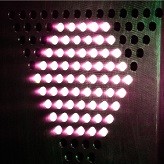The first laser pixels

 Based on an idea given by Gérard Mourou, Professor Emeritus of the Ecole Polytechnique and recipient of the 2018 Nobel Prize in Physics, the XCAN prototype is a system composed of 61 laser beams from the same source, allowing them to be combined together in a coherent beam (i.e. without losing the properties of the laser light).
Based on an idea given by Gérard Mourou, Professor Emeritus of the Ecole Polytechnique and recipient of the 2018 Nobel Prize in Physics, the XCAN prototype is a system composed of 61 laser beams from the same source, allowing them to be combined together in a coherent beam (i.e. without losing the properties of the laser light).
Developed within the Laboratoire pour l’utilisation des lasers intenses (LULI*) with the collaboration of the Thales company, the support of the Fondation de l'X and recent funding from the French AID, the aim of this program is to design a new generation of lasers based on the principle of separating the initial beam into a multitude of amplified fiber-guided beams, before being recombined to obtain high peak and average powers at high pulse rate.
Towards a digital laser

The design of the XCAN prototype is based on an independent control of its 61 beams, which can be considered as pixels of the overall laser beam. Their phase and amplitude are programable, offering unprecedented potential for shaping light in different power regimes. Thus, by applying a helical phase distribution, the XCAN team researchers were able to produce a ring beam. Their work was published this month in Optics Letter and highlighted as an Editor's Pick.

"This distribution can be modified in real time," explains Jean-Christophe Chanteloup, the CNRS researcher leading the project. "Along with kW operation, it opens interesting prospects in the field of surface treatment, cutting or precision drilling of materials, with a real-time optimization of the laser-material interaction".
> Discover the publication
> Learn more about the XCAN program (in French)
*LULI : Laboratory for the Use of Intense Lasers, a joint research unit of CNRS, École Polytechnique - Institut Polytechnique de Paris, CEA, Sorbonne Université
 Support l'X
Support l'X